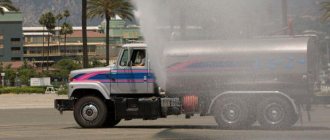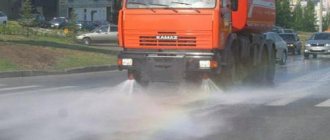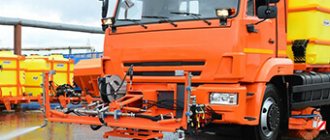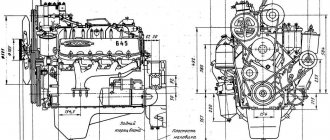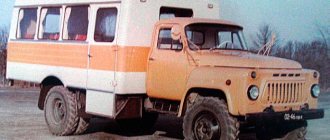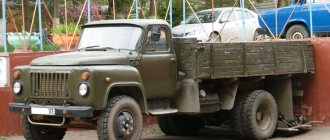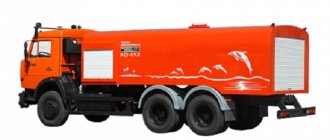General information
One of the most common types of municipal equipment has been and remains a watering machine. Units of this type have a wide range of applications - from washing roads and watering green spaces to extinguishing fires in case of emergency.
From the very beginning of production, the chassis of the ZIL-130 car began to be used for the installation of road washing equipment. Over the years, several versions of watering machines were produced - KO 002, PM 130 (watering machine), KPM 64 (combined watering machine) and AKPM 3. The tank of watering units was painted orange, the cabin could be of any color (most often sea green). An orange flashing signal was installed on the roof of the cab of later cars.
Watering machine based on ZIL-130
The watering machine, created on the basis of the ZIL-130, has a wide range of applications. This variation of specialized equipment is used to moisten and wash roads and sidewalks with different surface qualities. By using this model, green spaces can be watered and even fires can be extinguished. The ability to install additional equipment expands the functional potential of the machine.
In the winter season, the machine is transformed into a snow removal technique. For these purposes, a blade is installed in the front of the vehicle. This installation allows you to move snow drifts from the main road to the side of the road. At the same time, the brush that follows ensures the highest quality cleaning of the asphalt surface.
If necessary, the watering machine can be equipped with special equipment designed for spreading the reagent. This happens to combat ice.
There are a sufficient number of variations of watering machines on the market, but the model created on the basis of the ZIL-130 managed to achieve the greatest popularity. This trend is due to the design versatility and wide functional potential of the vehicle.
Compared to competitive models, this machine stands out due to the presence of a special system that allows you to remove residual sand from the body without using the built-in spreading disc. In addition, you should pay attention to the option of adjusting the width of the road surface.
In case of fire extinguishing, the watering machine acts as a water carrier. In this way, you can achieve more effective results in the fight against fire. Installation of additional equipment allows you to collect water from reservoirs. Additionally, the watering machine can clean storm drains.
Photo of a watering machine based on ZIL-130
Chassis
A watering machine based on ZIL-130 was mounted on a chassis with a standard base of 3800 mm. The cars were equipped with a carburetor eight-cylinder engine. With a working volume of just under 6.0 liters, the engine developed 150 hp. With. (with speed limiter). A76 gasoline was used as fuel. The engine was mated to a five-speed gearbox with synchronizers in gears 2-5. The rear wheels were driven by a cardan shaft.
The car's suspension was mounted on semi-elliptical springs, the front beam was equipped with hydraulic shock absorbers. The rear spring consisted of two parts - main and additional. Due to the almost constant load, the springs of the ZIL-130 watering machines were reinforced. The drum brake system was pneumatically driven. The steering was equipped with a hydraulic booster.
The driver's cabin was all-metal with a panoramic windshield. Standard equipment included an adjustable driver's seat, a two-seat passenger seat, a heater with a fan, and a windshield wiper wiper. Additional cabin ventilation could be provided through sliding windows, door windows and hatches in the cabin roof. On early releases there was another ventilation hatch in the area of the clutch pedal. Subsequently, it was removed, and after some time the hatches in the cabin roof were also abandoned.
Principle of operation
During operation, the water in the tank enters the inlet of the centrifugal pump. The liquid first passes through a water filter and a central valve. Subsequently, the pump directs the incoming water through the pipeline to the nozzles. The pressure water supply is equipped with two outlets to the valve, which are located in the side part. Fire hydrants are connected through these holes.
In this case, the pump pumps out liquid through a central valve and a strainer. Water is supplied to the pressure pipe and from there to the nozzles. The operation of the central valve is adjusted using a hydraulic cylinder. If necessary, the operator can change the angle of rotation of the nozzle used.
The operation of the watering machine in fire-fighting mode requires the operator to first connect the fire hose to the pipeline outlet. All other valves and taps must be tightly tightened. Otherwise, the necessary pressure will not be created.
The power take-off for driving the working parts is carried out through the use of a transfer case from a component of the base chassis installation. In this case, the required torque is transmitted to the gear pump of the vehicle’s hydraulic drive. Additionally, transmission is also made to the brush drive and the water pump, which provides water supply. The brush, which is used to remove debris, is located in the central part of the machine - between the front and rear axles of the wheels. In relation to them, the brush is installed with a slope of 28 degrees.
The design features of the vehicle allow you to fill an empty tank in various ways. It is quite possible to get by with a connected hose and fill the container from a nearby body of water. The main function of collecting liquid here is performed by a special water pump. It is also possible to fill the tank using a hydrant. An alternative way to resolve the problem is through the top hatch at a specialized gas station.
PM-130
This car is one of the most common models of the ZIL-130 watering machine. It began to be produced in 1965 at the municipal engineering plant in the city of Mtsensk. Subsequently, several more enterprises of the USSR mastered the production of the machine.
The capacity of the water tank was 6000 liters. Inside the tank there were breakwaters to increase rigidity and calm fluid vibrations during sudden maneuvers. Water was supplied to the pump from the bottom of the tank through a strainer with a sump. The container was filled with water from the water supply network or with a pump from any reservoir. To control the water level in the tank there were special viewing windows.
To pump water, the machine was equipped with a special centrifugal pump driven by a power take-off (PTO). The pump was mounted on the frame side member, and the PTO was installed directly on the vehicle's gearbox housing. All water supply nodes were interconnected by pipelines. There was a variant version of the machine with an additional tank trailer for 5000 liters of water.
In addition to the water supply system, there was an additional hydraulic system that served to control the brush and plow (during winter operation). For watering and washing, two rotating slot-type nozzles were used, mounted on a subframe in the front of the machine. A subframe with a rotating cylindrical brush for sweeping the road was installed between the bridges. The brush drive was carried out by a chain drive from the power take-off.
Device
The ZIL-130 watering machine is equipped with a tank for transporting water, which has the appearance of an oval-shaped welded structure. A special filter, pipe, sump and central valve are installed inside it. The presence of two breakwaters in the central part of the tank prevents the water from pumping during movement. The maximum capacity of the container is kept at 5000 liters. If necessary, this figure can be increased by 1000 liters by installing a special extension.
The central valve has a cylindrical shell, where two holes are located to retain a certain amount of water. This liquid is subsequently used to prime the water pump when drawing water from the reservoir. Thus, the central valve provides regulation of the water supply.
The watering machine has two rotary nozzles. They consist of special crevice-type nozzles and a rotating device. You should also emphasize the use of a pump that is attached to the right side member of the vehicle through the use of a bracket and stepladders.
The modification of the 130-B watering machine is additionally equipped with a fire hose with a barrel. This element is connected to the cross pipe. When the fire hose is running, all taps and valves for water supply must be tightly tightened. Model 130-P has an additional tank, presented in the form of a trailer. Its presence helps to increase the volume of transported water by 5000 liters. This tank is equipped with a sump and a plug valve.
An eight-cylinder engine capable of producing 150 horsepower is used as a component of the power plant. This engine is combined with a five-speed gearbox, presented in a mechanical version.
Considering that the vehicle is based on the ZIL-130, it has a dependent suspension on longitudinal springs. Double-acting hydraulic shock absorbers are installed in the front part, and additional springs are installed in the rear part. This design solution contributes to the most comfortable overcoming of the most problematic sections of the road with poor quality coverage.
The presence of a hydraulic power steering mechanism facilitates the steering process. The brake system is drum-type. The additional installation of a pneumatic drive improves the quality of functioning of the entire brake assembly.
The vehicle's gas tank is located on the left side member of the frame, and a pump is installed on the right. The machine has a closed power plant cooling system, which has the option of forced circulation of coolant. This is done through the use of a centrifugal water pump, which improves engine performance during operation.
KO-002
The production of the previous version of the ZIL-130 watering machine lasted about 20 years. Only in the mid-80s was it replaced by the modernized version KO-002. The car was produced at the same plant in Mtsensk. The operating principle and design of the main components and assemblies have not changed.
The main difference was the improvement in the technical characteristics of the ZIL-130 watering machine: an increase in the capacity of the main tank by 200 liters and the width of the coverage area when washing and watering. The operational speed when performing work has also increased slightly. This machine was the last highly specialized washing machine. All subsequent models of municipal units were equipped with a replaceable set of equipment - for the winter period, the tank was replaced by a module for dispersing the sand-salt mixture.

